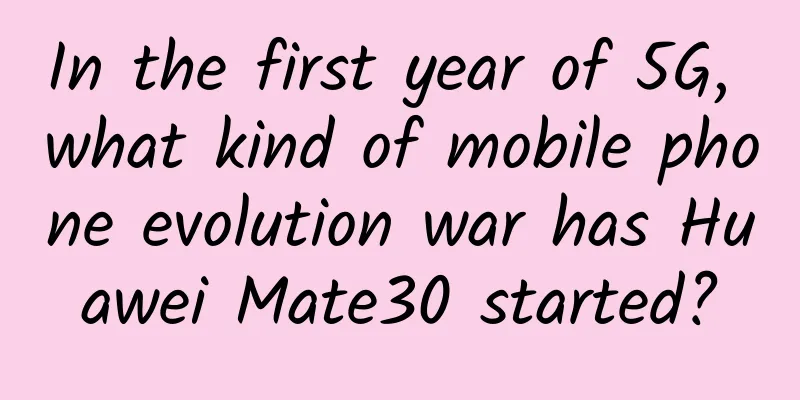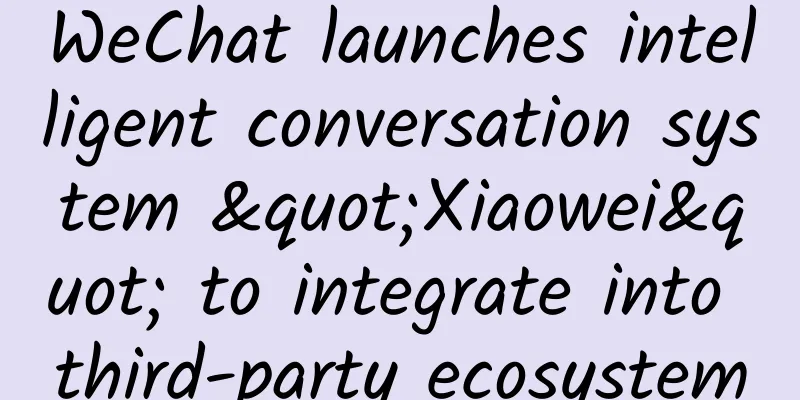In the first year of 5G, what kind of mobile phone evolution war has Huawei Mate30 started?

|
On September 19, 2019, Huawei officially released its strongest flagship Mate 30 series in the second half of the year. In addition to the same aggressive configuration as always, based on the support of Kirin 990, Mate 30 Pro officially used a combination of dual main cameras and four cameras this year. This combination, in today's world where triple-camera and quad-camera phones can only use one camera as the main camera due to the limitation of Qualcomm Snapdragon 855, has already taken over the position of the most powerful Android phone in the minds of many people, based on the Kirin 990's performance crushing over Snapdragon 855 and its ultra-high-speed photography capability of 7680 frames.
But among the many highlights of Huawei's annual flagship Mate30 this year, what caught the attention of Wuju Research Society was not the more professional photography capabilities, not the 5G baseband integrated SOC, nor the Kirin 990's performance crushing over the Snapdragon 855 under the support of extreme ultraviolet lithography technology, but the amazing AI capabilities of the Kirin 990 under Huawei's self-developed AI chip architecture, the Da Vinci architecture. According to Huawei Fellow Ai Wei:
Therefore, compared with the fast charging technology that major brands are now going all in on, Huawei still maintains the 40W action this year, which seems to indicate that Huawei is evolving "smartphones" towards "real smartphones" by improving the performance of edge AI based on SOC, rather than following the weaknesses of Apple and Samsung to make weak functional innovations. But what makes us curious is:
The evolutionary war of “real intelligence” in mobile phones "It's so hard to find a photo in a cell phone album nowadays. There are thousands of photos in it. It takes at least ten minutes to find the one you need." This is an experience point that a friend from the Wuju Research Society often complained about in a daily conversation. With the improvement of mobile phone camera capabilities, and the basic starting memory of mobile phones in 2019 at 128G, traditional classified albums can hardly meet people's daily needs. Therefore, after Huawei installed the Cambrian edge AI chip on Kirin 970 in 2017, the first thing it did was to enable the mobile phone AI to have photo recognition function. Following Kirin, Apple also built-in AI chip in A11 processor, and Qualcomm's flagship SOC Snapdragon also followed suit at the end of the year. According to an AI technical practitioner:
Although few people understood it at the time, Huawei and Apple added AI to their mobile phone SoCs. But two years later, in 2019, the average monthly traffic per capita in first-tier cities is no less than 10Gb, and the file size of mobile phone systems has begun to rival that of PC files. The photo recognition model pioneered by Kirin 970 has become a consensus among major mobile phone brands and mobile phone SOC developers on the evolution of mobile phone capabilities. The relevant data proves this: in the data of the top 20 AI-benchmark mobile phones, the Snapdragon 675, a new mid-to-low-end mobile phone SOC released this year, has the same AI performance as last year's flagship processor 845. Above the 845, there are only the three flagship SOCs of Kirin 990, Snapdragon 855 Plus and Snapdragon 855. There are also a number of emerging mid-range SOCs that can beat last year's Snapdragon U845 in terms of AI capabilities, including the Kirin 810, which ranks second in AI performance (Snapdragon 855 Plus ranks third and 855 ranks fourth), the MediaTek P90, which ranks fifth, Qualcomm 730 and MediaTek P90T, etc. At a time when mobile AI capabilities are evolving rapidly, another fact that is not well known to us is that according to AI-benchmark data, mobile AI performance is already higher than that of PCs. Among them, the AI score of the GeForce RTX 2080Ti, the third-ranked super graphics card on the PC, is only 25481 points, which is the same as the Orion 9825 processor of the Samsung Note10 ranked 20th or below. According to Huawei Fellow Ai Wei:
Therefore, based on the fact that NPU's AI performance is 50 times that of CPU, the AI capabilities of mobile phones have become a leading platform for the construction of the AI ecosystem, and have also become a new track for future mobile phones to open up differentiated experience. This differentiation is intuitively demonstrated on the Mate 30: based on the powerful AI capabilities of Kirin 990, Huawei directly demonstrated a black technology of "real-time video multi-instance segmentation". Real-time video multi-instance segmentation: A simple description can be understood as that the Mate30 series of mobile phones can directly "AI violently replace" the video background when recording video. Before this, on the Kirin 980, the Huawei P30 had a similar function that only turned the background black and white. And the AI applications on the mobile phone side are far more than that, because according to Huawei's official introduction: Huawei AI's API has been called 1.38 trillion times in the past, covering areas including photography, travel, shopping, health, education, creativity, art and many other aspects. Therefore, the situation is almost the same as the early 4G era when Android, WP, Symbian and IOS were fighting each other: Although the appearance of today's mobile phones has become homogenized and lost in the combination of notch screens, perforated screens, waterfall screens and various camera features, in the game of 5G era, upstream chip companies are betting on the strategic high ground of edge AI chips in an almost all-in manner. Judging from the AI black technology initially demonstrated by Huawei Mate30, AI has taken on the stakes of differentiating mobile phone experience, just as Apple must mark in the introduction of the A13 processor - "bionic". The motivation for technology giants to enter the market, in addition to the small profits in the mobile phone market, is the big business hidden behind artificial intelligence. The big gamble between 5G and AI In September 2019, because Kirin 990 and A13 were both released this month, there was controversy in the market very early on about the AI performance of Kirin 990 and Apple A13. Among them, according to an article released by foreign media mightygadget, Apple A13 can currently execute up to 10 trillion tasks per second, while the AI performance of Snapdragon 855Plus is 7 trillion times per second. Based on the fact that Kirin 990's AI score is more than twice that of Snapdragon 855Plus, Kirin 990 has basically become the biggest dark horse in edge AI this year. Therefore, when Huawei officially introduced Kirin 990 on September 4, the description used was: "The best 5G, the best performance, the strongest AI." Having higher AI computing power also means that Huawei can run more complex AI applications on the Mate30 series of mobile phones than Apple A13, and build a more powerful ecosystem based on AI performance in advance. This competition started as early as the Huawei HiSilicon 970 era, when it launched a comprehensive AI open platform based on the HiAI architecture, and the Apple A11 era, when it launched the non-open source machine learning framework Core ML. However, the competition in the AI chip battlefield is far more complex than that in the mobile phone industry. Because in addition to the familiar old faces such as Huawei, Apple, Samsung and Qualcomm, there are also multi-field and multi-dimensional experts such as Google, Microsoft, Amazon, IBM, Intel and Nvidia waiting in the wings in the competition for cloud AI chips and AI ecosystem construction. The motivation for these technology giants to enter the market collectively comes from the fact that the basic conditions for developing AI are becoming mature, and this condition is big data. For example, according to the "Data Age 2025" report released by IDC, the amount of data generated worldwide each year will increase from 33ZB in 2018 to 175ZB, equivalent to 491EB of data generated every day. Based on this fact, the earliest voice assistant AI that entered our daily lives was born in the past few years. Due to the maturity of 4G networks, we are almost providing training support for its "intelligence" with hundreds of trillions of information every day. Another related reality is:
Therefore, with the prelude to the Internet of Things opened by 5G, the data generated by the Internet will continue to increase exponentially in the foreseeable future. The essence of competing for the technological discourse power of 5G is to compete for the ownership of big data and the discourse power of the artificial intelligence industry hidden behind big data. In fact, according to the view mentioned by Huawei CEO Ren Zhengfei when selling "5G technology": "5G technology has indeed changed the communication era we live in, but in the end artificial intelligence is the really important thing, and the artificial intelligence industry can support the 5G era." Let's take a look:
Therefore, combined with the fact that after Huawei Mate30, Kirin 990 was immediately authorized for use in the new Honor phone, the ecological construction of end-side AI devices has become an important bet for Huawei in the next direction of AI. The logic is that the more Kirin 990 users there are, the more appeal Huawei's HiAI architecture-based comprehensive AI open platform will have to global AI developers. After all, no third-party developer would like to put in effort on a platform that has no user base and whose terminal devices cannot run their own programs. Compared with Huawei's current gamble on the AI ecosystem, Apple is the company with the most complete AI chip ecosystem. The reason for this can be traced back to Huawei and Apple's focus on edge AI. In the introduction of Core ML on Apple's official website, Apple describes it as: Using Create ML, you can build machine learning models on Mac with zero code. On Huawei's official website, HiAI is described as a computing platform for mobile terminal artificial intelligence (AI) that integrates three open platforms: terminal, chip, and cloud. Therefore, in the construction of the AI ecosystem, although the users targeted by Apple and Huawei are all at the terminal, Huawei's AI ecosystem also includes the "cloud" level deployed through Ascend 910. A higher-dimensional layout also means an increase in the difficulty of building an AI ecosystem. According to a Huawei technician, "Huawei abandoned Cambrian this year, not because Cambrian is not easy to use, but because it cannot meet Huawei's needs for building an AI ecosystem at multiple levels." The importance of connecting cloud and terminal AI, according to an AI practitioner:
Such interaction is not only high-speed and low-latency, but the most intuitive experience is power saving. This is an irresistible reason in the era of 5G high-power consumption smart terminals, and it also paves the way for the large-scale application of VR and AR in the future. Just like Huawei released a pair of smart glasses on wearable devices this year, one day in the future, mobile phones will only become a data transfer center for our wearable devices. Most of the time, we don’t need to turn it on. Most of the time, just looking at the watch or asking the glasses can solve 80% of the things we need to do on our phones today. This is the evolutionary war taking place between Huawei and Apple right now, but not all mobile phone brands can participate in this war. The AI entry ticket that was strangled in the 4G era Huawei, Samsung and Apple are actively developing edge AI, but other mobile phone brands are struggling with differentiated innovation. Because according to the latest data from the statistics agency Canalys, at a time when the international mobile phone market is currently experiencing a cold winter, Samsung, Huawei and Apple alone account for 50% of global mobile phone shipments. In the domestic market, thanks to the efforts of Huawei HiSilicon, a new high in market shipment rate has been achieved in recent years. According to an industry insider:
To this end, he gave the example:
In addition to Google Pixel, Wuju Research also learned that Nokia 9 PureView and some Sony models also adopted the same "compromise" method. After Apple's A13 processor added AI to iPhone photography, Apple's strategy is also to use chips to perform continuous synthesis of multiple photos. For example, Apple’s mobile phone camera has a dynamic photo function. Although this function also has similar copies on Samsung and other mobile phones, the actual imaging effect is based on the different camera scheduling of the mobile phone SOC. The imaging of dynamic photos is far less clear, natural and shocking than those taken by Apple mobile phones. The reason why mobile phone manufacturers are in a dilemma today where only Huawei, Samsung and Apple can differentiate themselves is because of the mobile phone SOC integration solutions promoted by MediaTek and Qualcomm. After 2010, as MediaTek and Qualcomm, the two major chip giants in the 3G and 4G era, integrated multiple functions such as CPU, GPU, ISP, GPS and signal processing chips and launched mobile phone SOC (systemized solution), the identity of mobile phone manufacturers began to change to mobile phone designers. Under such a trend of the times, although a number of once-glorious "mobile phone design companies" such as HTC, LeTV and Dakele were born, the fact that Qualcomm dominated the market after MediaTek's failure to impact the high-end market has also led to a highly homogeneous situation in the mobile phone market today, on the eve of 5G, with only four options left: Huawei, Samsung, Apple and Qualcomm. In particular, the competition for edge AI chips that suddenly broke out in the 5G race has made companies that once gave up on developing their own chips deeply realize the importance of chips in the 5G era. However, today, the threshold for chips is no longer what it used to be. Born in hardship and die in comfort, this has become the most vivid reality of the mobile phone manufacturers on the eve of 5G: "You will pay for what you have done sooner or later." Therefore, as early as December last year, Honor President Zhao Ming bluntly said: "There will only be 4 or 5 global mobile phone brands left." According to Zhao Ming, "Today, mobile phones are no longer just a communication tool. They carry many other things. These are not something that small companies can do. They are the result of the development of science and technology." Although many people were skeptical about this view at the time and naively believed that the mobile phone market could survive well like in the 3G and 4G eras, relying on endorsements, appearance and positioning differences. But those of us who once held this view may have underestimated the force and terror of the market reshuffle in the era of 5G true intelligence. Of course, based on the basic fact that Qualcomm is still the leader in 5G core technology and Qualcomm SOC still occupies more than 70% of the global mobile phone market (Samsung and Huawei still purchase Qualcomm SOC for some models), companies that only do mobile phone design will not be without a market in the 5G era. It’s just that the market’s voice and profits are not in the hands of these mobile phone manufacturers. What they can do is either to switch to cloud AI layout like Xiaomi, and use the loT market to differentiate the experience beyond mobile phones; or to learn from Huawei's tactics in the 4G era, and find differentiated user positioning beyond the user pain points of Samsung and Apple to accumulate strength for development. However, for those mobile phone companies that used to be accustomed to "taking what is available", their turnaround in today's situation is not as easy as Huawei's bet on K3V2. The Tragedy of Technology At the end of 3G, Bird, TCL, Xiaxin, Konka, Eastcom and Kejian collapsed. At that time, mobile phones were still mobile phones. Their biggest functions were to make calls, send text messages, and occasionally watch offline videos and listen to offline music. Mobile phones were representatives of technological products, and most mobile phone manufacturing companies were still mobile phone R&D companies. At that time, the right to speak on mobile phone innovation was still in the hands of most mobile phone companies. In the 4G era, with the departure of LeTV, HTC, Sony Ericsson and Motorola, and with the rise of mobile games and short videos, mobile phones have become personal entertainment centers and network interaction centers. However, as mobile phones have become more and more versatile in the 4G era, their innovative capabilities have also rapidly deteriorated under the global division of labor. According to a comment from an industry insider:
We cannot stop global companies from commercializing their respective fields, nor can we find a company that can survive independently without global companies, so we cannot say that mobile phone companies that choose other people's SOC are taking shortcuts. Xiaomi, which once made mobile phone SOC for technological independence, should be the one who understands the difficulties. In a social environment where 5 billion can buy a headquarters building, according to Huawei Fellow Ai Wei, the starting price of chip research and development is hundreds of millions of dollars. It is far from the payback effect that can be easily achieved by spending tens of millions of cash at the annual meeting or hiring a celebrity to endorse the product. It is even far less than the experience improvement that can be brought about by the technological breakthrough other than the previous chip. Therefore, at a time when Samsung's technology and Qualcomm's SOC still represent the physical experience limit of other mobile phone manufacturers except Huawei and Apple, the changes that are happening in the world may be just like what Huawei Fellow Ai Wei said: Technology is cumulative, unlike money, which can be quickly earned through other means if lost, but not technology. Just like this year, a company sold its baseband, and they were not short of money. This company, which is not short of money, can't even make a good baseband. Our domestic mobile phone brands are not as wealthy as Samsung and Apple, so there is naturally no reason for us to catch up with Qualcomm in SOC research and development. But the real difference is: As the market competition becomes fierce, we lack enterprises that face the technological reality calmly. Instead, more brands choose to claim ownership of what they have acquired through micro-innovation. There are already countless hot images comparing parameters of various mobile phones on the Internet, and the comparison culture that started from offline salesmen to promote their own mobile phones is tearing apart the unity that domestic mobile phone consumers should maintain among mobile phone brands. As a rational technology enthusiast, I, who uses Samsung, cannot say that I identify with Samsung or prefer any domestic brand, let alone the absurd rumor that "buying a mobile phone means patriotism", which even Ren Zhengfei denied amid the craze. What I hope is that everyone can calm down, find their own direction in the tide of the 5G era, and truly innovate functions for user experience. Don’t let the violent competition among mobile phone brands leave too many unpleasant memories for media professionals and consumers who are currently using “domestic mobile phones” in an era that should be the eve of 5G. After all, we are still willing to believe that the powder keg in the comments was not "exploded" by consumers themselves. |
<<: How did NetEase Cloud Music and Mobile QQ change their skins?
>>: What is considered advanced Android? I suggest you master these points
Recommend
SEO optimized website has been included but is not ranked? How long does it take to be included and ranked?
Bosses who are familiar with SEO optimization kno...
Muzi Hongtu's "Tutorial on Starting a Live Streaming Account with 0 Fans" - Logical steps to start a live streaming account with mainstream gameplay
Course Contents: 1-2022 must read 2- How to break...
Zhulu Video Account 1.1 Operator Practical Operation Course New Platform New Opportunities, Build a Private Domain Traffic Position!
Zhulu Video Account 1.1 Operator Practical Operat...
The latest Google Admob channel promotion strategy in 2015
According to statistics, taking Android as an exam...
What does it mean to clear the epidemic situation to zero? How long will it take to be unblocked after being cleared? What is the difference with static clearing?
During the epidemic, we often hear about dynamic z...
Microsoft Venture Accelerator achieved 30 million users without spending any money? The trick of "Bump" is...
The following content is compiled from the live s...
Easily master the basic programming algorithms (Part 3)
[[121972]] Basic Programming Algorithms (I) Basic...
React Native-Currently the hottest front-end technology
[[160497]] As a product manager, have you ever en...
Talk about iOS identification virtual positioning research
[[415572]] This article is reprinted from the WeC...
What does a high-conversion information flow ad look like?
For information flow advertising , the content an...
Strategy! Answers to the 4 most common Baidu search ads problems
There are too many display styles for Baidu searc...
How long does it take to be included in Baidu? What is the reason for slow website inclusion?
Baidu algorithm is constantly upgrading, paying m...
How to operate and maintain her community with millions of monthly active users in 8 months
This article is the on-site dry goods of WOT2016 ...
From 0 to 1, how to write a marketing plan with "soul"?
"Every marketing plan with soul must not be ...
A blind candidate from Anhui scored 635 points in the college entrance examination. Who is the blind candidate from Anhui?
A blind candidate from Anhui scored 635 points in...









